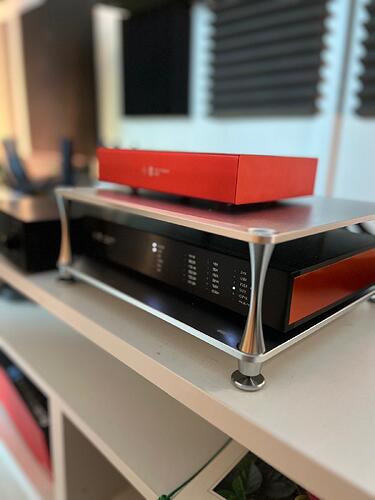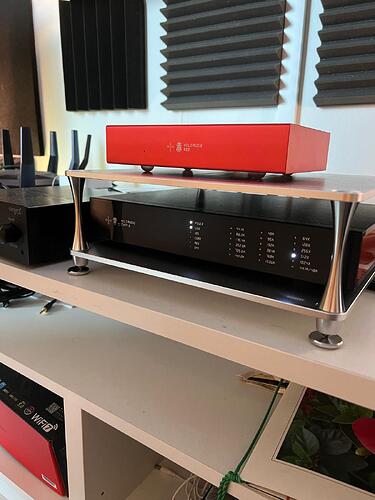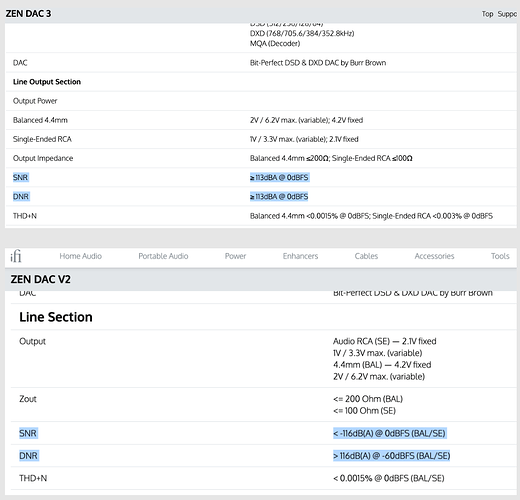![]()
![]()
![]()
![]()
![]()
![]()
You can actually add many new ESS DACs to the same category, running out of single 100 MHz clock with ASRC active.
I heard the ES9039 is just a minor upgrade to the 9038. I look forward to your detailed info later.
Wow… I am listening to sinc-L at this moment. No wonder it sounds so good. Yeah
And it is not limited to doing just 16x output rate, like WTA1 is. If you have powerful enough GPU with enough RAM, you can run it to DSD512. Meaning it is hammering a 64 million tap filter at 22.5792/24.576 MHz sampling rate (not just mere 705.6/768 kHz).
Too bad, it is something I would like to try but my current DACs only support up to DSD256…
Just wondering if doing the same but with DSD would make a big difference (i.e. worse) ?
44.1k ====> upsampled to DSD256 with HQPlayer’s filter/shaper ====> (to Chord) Chord DAC’s own SDM ===> analog output
![]()
Just wondering if doing the same but with DSD would make a big difference (i.e. worse) ?
44.1k ====> upsampled to DSD256 with HQPlayer’s filter/shaper ====> (to Chord) Chord DAC’s own SDM ===> analog output
Chord converts all DSD inputs to 705.6k PCM (with a conversion that aliases some noises down) and then runs it through their modulator again. So counter-productive…
Dave has some “DSD Direct” 'ish mode, but I have not measured how that works.
And I don’t agree with their reasoning.
It’s one of the primary reasons I own a HQPlayer license. It’s amazing the world we live in that, not only do you get choice, but you get to interact with the people bringing to market that choice. It was probably mid 2000’s where I decided that sending DSD to a DAC made a heck of a lot more sense than PCM (except maybe R2R… but I need to buy my R2R DAC to test). Here we are, 2 decades later and HQPlayer makes that choice an easy reality. And it’s cheap! (relatively). I think the work Watts did with m-scaler is spectacular. It’s just not exactly cutting edge because it’s truly limited by living in a passively air-cooled “appliance” when everything is solved by maths. Do more maths more faster and you get better results. That just takes hardware. I wonder, if Watts wasn’t admitting to limitations of his own product, what number of taps he’d think was the ultimate endgame if given unlimited clock cycles.
A huge feature of HQPlayer is, when we learn new things, we get to upgrade to those new things and someone like @jussi_laako doesn’t have to justify where we were to keep selling “last years” hardware product. Good stuff indeed.
A huge feature of HQPlayer is, when we learn new things, we get to upgrade to those new things and someone like @jussi_laako doesn’t have to justify where we were to keep selling “last years” hardware product. Good stuff indeed.
Looks like a great DSD direct DAC would be an end game for you. Hope you can get the best one soon ![]()
@jussi_laako sorry for being side track a bit … quick questions for you ![]()
-
I know HQPlayer does aware of the MQA tag in the music file (as it shows [MQA]) on the HQPlayer screen. Does HQPlayer do anything about it other than displaying the tag? I also noticed that if a MQA file does not have the MQA tag, HQPlayer won’t show MQA.
-
Should we have Roon (or something similar) to unfold the first MQA layer before feeding it to HQPlayer?
-
I think you did recommend to use MQA specific filter for MQA files. Are the other non-MQA filters work well too (as I like the sinc-L)
I know HQPlayer does aware of the MQA tag in the music file (as it shows [MQA]) on the HQPlayer screen. Does HQPlayer do anything about it other than displaying the tag? I also noticed that if a MQA file does not have the MQA tag, HQPlayer won’t show MQA.
HQPlayer does some cleanup of such sources to reduce noise caused by the MQA encoding. I could also add detection for the actual MQA stream as well, but not sure if it is hugely useful now that MQA is disappearing anyway.
Should we have Roon (or something similar) to unfold the first MQA layer before feeding it to HQPlayer?
Yes, that is better alternative.
I think you did recommend to use MQA specific filter for MQA files. Are the other non-MQA filters work well too (as I like the sinc-L)
You can use other filters as well, especially if you let Roon do the first unfold.
As usual, I recommend to use notably shorter filters than sinc-L for content that contains notable transients. This is not related to MQA directly.
HQPlayer does some cleanup of such sources to reduce noise caused by the MQA encoding. I could also add detection for the actual MQA stream as well, but not sure if it is hugely useful now that MQA is disappearing anyway.
Adding that feature would be great as there are still quite a lot of MQA contents around in the MQA-CD format (other than MQA stream). Looks like MQA-CD is well accepted in Japan and China. They called these CD as MQA-UHQCD.
From my observation, these CDs are getting quite popular in Asia (especially Japan). HMV & BOOKS online [English Site]. They are still issuing new titles in this format.
I am wondering if the recent event happened to MQA may actually help to make MQA more readily available (in MQA-CD format) instead of dying down.
I am wondering if the recent event happened to MQA may actually help to make MQA more readily available
I really hope not! MQA CD is even worse quality disaster than the regular MQA ever was!
I really hope not! MQA CD is even worse quality disaster than the regular MQA ever was!
I think it is lossy (fake) DXD vs loseless red-book. ![]()
![]()
@jussi_laako I am quite interested in this DAC (Zen DAC 3). Just wondering if you will test it in the near future? I want to see how it perform with DSD512.
By the way, for the Sony 1Z (old version, not the 1ZM2), not sure if you mind used stuffs. It is available around $900 for a used one ( wm1z for sale | eBay
For $900, it is definitely a decent DAP for that price.
I am quite interested in this DAC (Zen DAC 3). Just wondering if you will test it in the near future?
At least it doesn’t seem particularly expensive. So yes, possibly I will test it. I’d also like to test the NEO iDSD 2.
Let’s see if there will be some other interesting ones appearing at Munich show.
At least it doesn’t seem particularly expensive. So yes, possibly I will test it. I’d also like to test the NEO iDSD 2.
Great! Thanks a lot.
From the spec, it doesn’t look like it is better.
Story doesn’t tell which format they used for the specs. But v3 supports DSD512 and 16x PCM while the v2 is half that.
Possibly they updated the xmos which is now in-line with the NEO which also supports 16x PCM and DSD512…
The main focus on the Zen 3 is probably the headphone XBass+ and PowerMatch analogue processing modes


